Be Aware Of Black Ice When Taking Your Pets For A Walk

Today we are more aware of the far-reaching dangers of walking on ice and the injuries it can cause. Whether at home or work, winter is when you will encounter black ice (a thin invisible icy layer on concrete that merges with the pavers or road). While we often take care of ourselves while stepping out, we need to pay attention to our pets as well.
How Does Black Ice Form?
Black ice is formed when rain and snow falls and the temperature climbs above freezing point. It can also form when dew or fog develops and the temperature freezes again. On the road, it will begin when the heat of the car tires is coupled with the freezing temperature. There is an instant freeze/thaw/refreeze cycle that creates this phenomenon.
How do pets get affected, and how can you prevent the dangers of walking on ice?
Pets’ paws can withstand quite a bit of aggression; however, sometimes extreme temperatures can affect their ability to safely walk on ice. Just the way warm temperature and hot weather pose a threat to your pets, similarly extreme cold does the same too.
- Frostbite
Pets’ paws are susceptible to frostbite in frigid weather. You must check their paws frequently for any signs of frostbite or cracking, or bleeding. If you notice a slight limp in their walk or sudden difficulty in walking, it is most likely due to an injury. When you take your pets out for a walk, using Walk On Ice will help them tread carefully and eliminate the dangers of walking on ice.
- Wipe down their paws
Whenever you get back from a walk, wipe down their paws, belly, and legs so that they do not feel cold. There could be other chemicals around the premise you are unaware of that can make them feel uneasy. Using pet-safe traction products such as Walk On Ice will help them walk properly without worrying about wiping their paws.
- Warm socks
There is nothing more heartbreaking than to see your pet slip on black ice and injure themselves. Making pets wear warm winter socks can help put off getting injured or slipping completely. Although this is one way of assisting them to safely walk on ice, it is also advisable to use environment-friendly traction agents, such as Walk On Ice, to make the surface anti-skid.
What Time Of Day Does Black Ice Occur Most Often?
If you’ve ever wondered why your morning dog walk feels like stepping onto a hidden skating rink, the timing explains a lot. What time of day does black ice occur most often? Typically, it forms in the early morning hours—right before sunrise—when the overnight temperatures drop below freezing. It can also catch you off guard in the evening after the sun sets.
The tricky part? Even if the air temperature has risen above freezing during the day, leftover moisture from melted snow or dew can refreeze once the temperature dips again. That means late-night potty breaks for your pets or those early-morning strolls are the riskiest times. Knowing this, it helps to prepare ahead: keep Walk On Ice handy and sprinkle it on your porch steps or driveway before heading out. That way, both you and your furry friend are less likely to slip.
Can Black Ice Form Without Rain Or Snow?
Here’s where many people get it wrong—can black ice form without rain? Surprisingly, yes. It doesn’t always take a storm to create dangerous conditions. Black ice can form when there’s dew, fog, or even condensation that freezes overnight. Bridges, shaded sidewalks, and areas near water sources are particularly vulnerable since they cool faster than surrounding ground.
For pet owners, that means don’t let the absence of rain or snow fool you into thinking your walk is risk-free. Even a perfectly clear night can leave behind patches of invisible ice by morning. The safe play? Before letting your pet run ahead on a leash, scan the walkway, and if you spot any unusually shiny or glossy areas, avoid them—or better yet, create traction with a safe, natural product like Walk On Ice.
Get ready for winter with Walk On Ice instant traction on snow and ice
How To Melt Black Ice (And When You Shouldn’t)
Pet parents often ask: how to melt black ice without harming pets or damaging surfaces? The answer depends on what you’re using. Traditional rock salt and chloride-based melts are harsh on concrete and can burn your pet’s paws. They may eventually melt the ice, but they’re not safe long-term solutions.
Safer alternatives, like pet-safe ice melts (such as Safe Paw), can melt ice without chloride burns, but keep in mind—they take time. That’s why traction agents like Walk On Ice play a different but vital role. Instead of waiting for ice to melt, you get instant traction, which is especially important when you just want to step outside with your pet quickly.
So, the rule of thumb is: use safe deicers if you need to melt ice over hours, but reach for a traction agent if you need immediate, walkable safety. Both serve different purposes, and together, they give you a complete winter safety strategy.
What To Do When You Hit Black Ice (With Or Without Pets)
Now, let’s shift gears for a moment. Even if you’re cautious, sometimes you can’t avoid black ice—whether walking your dog or driving to the vet. So, what to do when you hit black ice?
- On foot: Stop suddenly shifting your weight. Keep your knees slightly bent, arms out for balance, and take small, flat-footed steps until you reach a safe patch. If your pet pulls on the leash, pause, steady yourself, and then move slowly together.
- With your car: Resist the urge to slam the brakes or yank the wheel. Instead, lift your foot gently off the accelerator and steer in the direction you want to go until the tires regain traction. It’s the same principle as walking—slow, controlled movements prevent accidents.
For both cases, preparation is the real lifesaver. At home, keep your steps and driveway treated with a traction agent so you never “hit” black ice in the first place. On the road, stash a canister of Walk On Ice in your trunk—it can help free your car if you do end up stuck.
Wrapping It Up: Smarter Black Ice Awareness For You & Your Pets
So, while the dangers of black ice can’t be underestimated, the real key lies in awareness and preparation. It’s not just about asking, what time of day does black ice occur, but also knowing that it can happen even without rain or snow. It’s not only about figuring out how to melt black ice, but also recognizing when traction is the safer, faster choice. And most importantly, it’s about understanding what to do when you hit black ice, whether you’re on two legs, four paws, or four wheels.
Your pets rely on you to keep them safe, and with tools like Walk On Ice, plus safe deicers where needed, you can confidently face winter’s hidden hazards. Instead of fearing those frosty morning walks or late-night potty breaks, you’ll know you’re ready—one careful step at a time.
Other Ice Melt Products
Safe Paw
The Original and #1 Selling Pet and Child Safe Ice Melt for over 20 years. Guaranteed environmentally safe – will not harm waterways and sensitive wetlands. All products are made in the USA.

Safe Thaw
Imagine an ice melt you can put down and never worry about. It won’t harm pets, kids, and your property. That’s Safe Thaw. Unlike anything else on the market, Safe Thaw can change how winter affects our planet.



